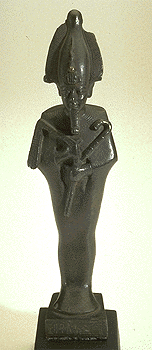 |
|
Internal Organs The first step in the embalming process was to remove the brain using a long metal hook inserted through the nose. The Egyptians thought that the heart was the center of thought, therefore the brain was of little value. Secondly, an incision was made in the left side of the abdomen, and the stomach, intestines, liver, and lungs were taken out. These were removed extremely carefully in order to damage the corpse as little as possible. The head was left in place. The body cavity was then stuffed with packets of linen filled with a salt called natron . |
 |
The stomach, liver, intestines, and lungs were mummified separately and placed in individual containers called canopic jars. Each organ had a specific god to watch over it. These four gods were called the Sons of Horus.
The lid of each jar was made in the form of the watchful god. These jars could be made from wood, stone, pottery, or other materials, and were often stored in the tomb in their own stone or wooden chest.
|
 |
| This picture shows a mummy lying on a lion-decorated embalming table with four canopic jars placed under the table. |
 |
 |
 |
 |
 |
 |
© Michael C. Carlos Museum of Emory University,
Memorial Art Gallery of the University of Rochester and Dallas Museum of Art
For more information please contact odyssey@emory.edu.
Last Update: